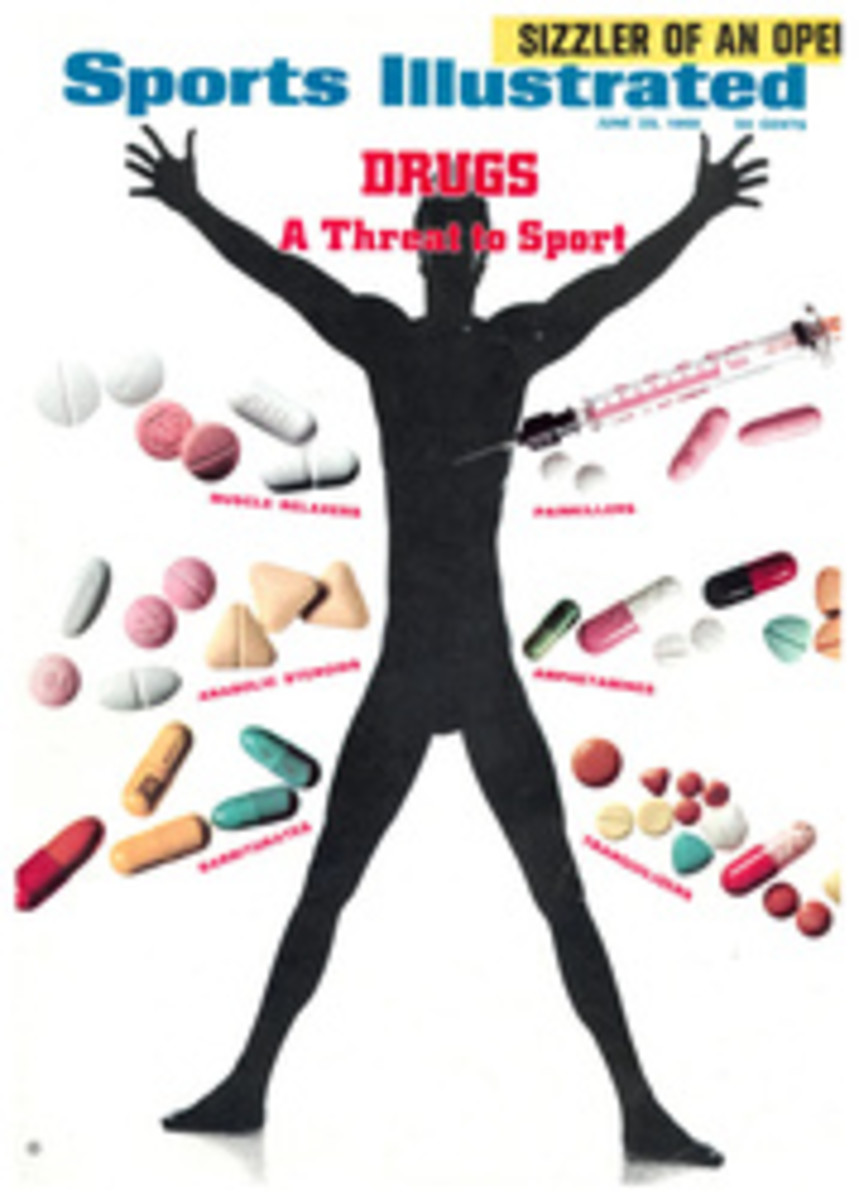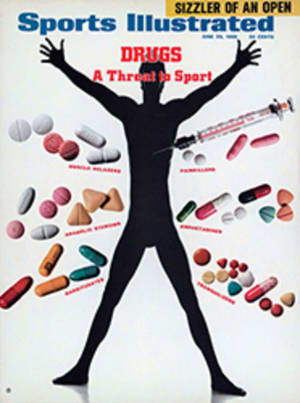
A day for Henry and Georges
There were two pretty big races in France last weekend, one for the presidency and one at Le Mans, and the way things were at Le Mans even the most loyal fan could have been excused if he had stayed home to give some last-minute thought to the respective horsepower of M. Pompidou and M. Poher. The German Porsche factory had already clinched the World Manufacturers' Championship and appeared to be so strong in France that a 1-2-3 finish would have surprised no one. The Ford GT40s of England's John Wyer were old stuff, Ferrari had a token entry, the French Matras were unproved and it was 100 to 1, as usual, against any kind of a close race toward the end of the 24 hours. Endurance races just do not produce close finishes.
And so 300,000 Frenchmen came to Le Mans—and in the last three hours not only saw Porsche beaten but witnessed this miracle in a car-to-car duel worthy of a Grand Prix sprint. By then only one of the six factory Porsches was still alive, a 908-model prototype driven by Hans Herrmann and Gerard Larrousse. Both of Wyer's GT40s were healthy and the one driven by Jacky Ickx and Jackie Oliver was nose to tail with the Porsche. As these cars stormed around the course at speeds close to their fastest qualifying sprints, even Rico Steinemann, the Porsche team manager, was looking on like a fan. "Fantastic, fantastic," he said to everybody who came near him as he stood, enraptured if a little nervous, still as immaculate in sports coat, shirt and tie as he had been the previous afternoon.
In the last hour the lead changed six times, and the Ford's final margin, with the Belgian Ickx at the wheel, was no more than 100 yards. And so Le Mans maintained its tradition of being thoroughly French in everything except the winning car. The countryside surrounding the 8.3-mile circuit was one huge nationalistic picnic, replete with fairs and carnivals, p√¢té and wine, Jean-Claude Killy in a Renault-Alpine and, thank goodness, les jeunes filles. And though a French car had not won since 1950 there was something more than the usual forlorn hope. Never mind that one of the French Matras, driven by Johnny Servoz-Gavin, nearly wiped out three officials shortly after dark when he pulled out of his pits—in reverse. Matra was there, and Matra challenged well.
The Matra company is basically one of France's leading defense contractors—missiles and that sort of thing—and hardly one that you would expect to be involved in racing. But a few years ago the company's president, Marcel Chassagny, had a talk with a small racing-car contractor named Henri Bonnet, who had a shop near the main Matra plant in Paris. Since Chassagny is something of a sports nut, one thing led to another and before long, with the aid of ELF, a French gasoline company, and substantial support from the French government itself, Matra got into the racing-car business. Its Formula I effort is well known, of course, because Jackie Stewart very nearly won the world driving championship in a Matra-Ford last year and is challenging for it again this season, but its sports prototype program is something else.
Last year Matra entered just one car at Le Mans, and that only at the insistence of the French government. Even so, at one time the car was running second and it lasted 21 hours before failing. This year Matra was a lot more serious about Le Mans, but until last week all the pretty blue cars had done was crash a lot. Henri Pescarolo totaled one car during practice for the Daytona Continental, and then in April during a secret test on the Le Mans circuit Pescarolo launched himself like a Matra missile near the end of the Mulsanne Straight and was severely burned. (About the only good that came out of the second accident was that the Le Mans organizers finally put up guardrails along the straight, a 3½-mile-long speed chute where the most powerful cars easily reach 210 mph.) Despite these disasters, four of the Matras, all powered by three-liter V-12 engines, showed up on the grid for the drivers' footrace known everywhere as the Le Mans start.
Just before the start, Sam Posey, one of only two American drivers in the race—and isn't that a surprise, considering the Ford Motor Company's recent dominance?—said, "In endurance racing, the driver is only a negative factor. The only way he can affect the outcome is to make a mistake." Barely four minutes into the race, just after the leading cars completed their first lap under a hazy sky later penetrated by sunshine, the first mistake was made, and it cost an obscure British driver named John Woolfe his life.
Less than a week before Woolfe had picked up the first of the Porsche 917s to be sold publicly, one exactly like the car with which Britain's Vic Elford and Dick Attwood were to dominate much of the race. Woolfe qualified the car well and on the first lap was euphoric, until he entered the White House turn—a 130-mph left-right—too fast. He got sideways halfway into the turn, shot across the narrow track and hit the outer embankment practically head on, then caromed to the opposite side of the road. The car burst into flame and Woolfe died instantly.
Directly behind Woolfe was Chris Amon in a Ferrari 312P, which had been the fastest of the Italian cars in practice. Amon ran over one of Woolfe's flaming wheels and at first thought his car had exploded as well. It hadn't, but the car was covered with fire and Amon suffered slight burns over his right eye while vacating the Ferrari. "I watched Woolfe for two miles and he was all over the track," Amon said. "I was trying to stay out of trouble. I don't need that sort of thing."
After that, the race quickly settled down to a three-cornered duel among the Matras, the Porsches and the five-liter John Wyer GT40s, similar to the type that had won in 1968.
Everybody knew Wyer's plans and his team's capacities. Since the Fords obviously were not nearly as fast as the Porsches or Matras, Wyer (by remote control from England, where he was attending his sick wife) would run a relatively cautious race, hope the leaders would overreach themselves and make his bid during the last hours of the race.
Porsche, French nationalism aside, had to be the favorite. This year has been the most successful in its history. After an awkward start in America, where Porsche had managed to lose at Daytona to a pair of Lola-Chevys and at Sebring to Wyer's reliable GT40s, the Stuttgart works had assured itself of the World Manufacturers' Championship for the first time by taking all five previous European races counting toward the title—at Spa, Monza, Brands Hatch and the N√ºrburgring in addition to the Targa Florio. However, Porsche had never won Le Mans outright and very nearly didn't enter.
The trouble was a flap over flaps, i.e., movable spoilers at both ends of the rear wing of the 917s. The CSI, which is the competitive arm of the FIA and which had hastily banned airfoils on Formula I cars last month, told Porsche it couldn't run with the wings or the flaps. Porsche, in turn, told the Le Mans organizers that if they couldn't run with the wings, they wouldn't run at all. They already had their world title and, besides, they had gone well over the racing budget for the year.
A compromise was reached, under which the 917s could run with wings and flaps, the 908s with wings only. That satisfied everybody, especially since the best Porsche of all, the 908 driven by Jo Siffert and Brian Redman, which had won four of those five European races, did not have a wing at all but rather two fins, vintage 1958 Cadillac, sticking up from the rear fenders.
The race began as a Porsche parade, a 917 driven by Rolf Stommelen and Kurt Arhens leading through the first hour, but the car was ailing from a faulty exhaust and an oil leak that finally forced it to retire at 3:50 Sunday morning. Next to lead was the Siffert-Redman 908, which prospered until an oil leak caused its gearbox to seize. Then Elford and Attwood took over and, considering that their car had appeared in only two previous races and had not done well in either, performed impressively as long as it lasted.
The Matras had their moments, especially an open-seat spyder driven by Jean-Pierre Beltoise and Piers Courage. At the seven-hour mark it had moved into second place, but then all sorts of trouble began to overtake it. First the Matra crew took an abnormally long time to replace brake pads. Then, with night approaching, crewmen took 20 minutes to get the car's rear lights working. Minor but time-consuming problems, like Servoz-Gavin's miscue in the pits, plagued the others, forcing the retirement of one and costing the rest whatever chance they had for victory. Still, the French fans would not give up and into the last hours of the race cheered wildly every time one of their cars roared down the pit straight.
The Ford GT40s, on the other hand, were trouble-free, and through the long night hours, when the Matras fell back and another contending Porsche driven by Gerhard Mitter crashed at the end of the Mulsanne Straight, the Fords pushed forward. By dawn Ickx-Oliver were third and the second GT40, driven by David Hobbs and Mike Hailwood, was fifth. Just before 11 a.m. the second-place Porsche, driven by Willi Kauhsen and Rudi Lins, retired, and the Fords were second and fourth. And just after 11 the leading Elford-Attwood Porsche was parked. Oliver and Ickx had been seven laps behind, but now there was no rush, and they were already getting the slow-down sign from their pits.
They had to step on it again, of course, when the Herrmann-Larrousse Porsche fought so brilliantly in the last hours, and in the end there was something for nearly everybody, even the French. A Renault-Alpine (not Killy's, sad to say) had won the Index of Performance, and Matras had manfully finished fourth and fifth. People who did not get home in time to vote discovered it did not matter. Pompidou won his race quite a bit more handily than the Ford.
PHOTO

